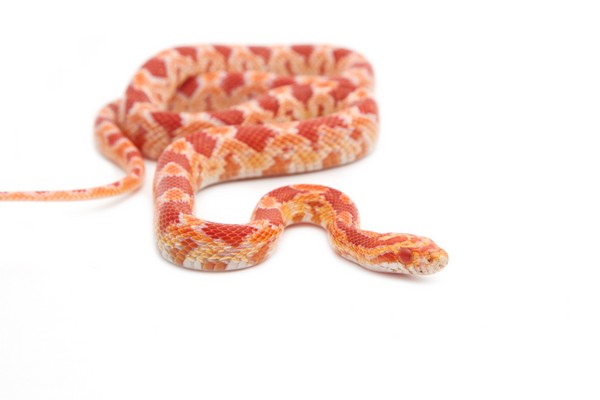What Are Good Pet Snakes for beginners? Choosing the right snake can be an exciting adventure, and at PETS.EDU.VN, we are here to guide you. This comprehensive guide explores the best snake breeds for pets, offering valuable insights into snake care and maintenance to ensure your scaly friend thrives. Discover the ideal reptile companion and unlock a rewarding experience in reptile ownership! Let’s explore fascinating reptile keeping, pet snake ownership, and reptile care.
1. Understanding Snake Basics for Beginner Keepers
Snakes, unlike other reptiles, move using a unique slithering motion facilitated by an elongated spine consisting of up to 100 ribs, each connected to powerful muscles. This allows for smooth, undulating movement, a captivating display of natural engineering.
Their respiratory system features nostrils on their snout connected to the glottis, a vertical slit that opens into the trachea. This adaptation allows them to breathe even while swallowing large prey, highlighting their remarkable physiology. Like other reptiles, they lack a diaphragm.
The diets of snakes vary based on their size, ranging from small rodents to larger animals. Snakes typically swallow their prey whole, relying on potent stomach enzymes to digest even bones, with hair being the only indigestible component, which they excrete as pellets.
Each snake species exhibits a unique temperament, with some being docile and easily handled, while others can be more aggressive. Understanding your snake’s body language and respecting its boundaries is crucial for fostering a positive relationship. PETS.EDU.VN offers detailed guides on understanding snake behavior and building trust with your pet. For example, a hissing sound can mean they are irritated or feel threatened.
2. Top 10 Recommended Pet Snakes for Beginners
Selecting the right snake for your first pet can be overwhelming, given the variety of species available. Here’s a curated list of the 10 best snakes for pets, perfect for beginners:
2.1. Corn Snake: The Docile Choice
Corn snakes, native to grasslands and abandoned buildings, typically range from 24 to 72 inches. Known for their docile and friendly nature, these snakes are less prone to biting, making them an excellent choice for new owners. To mimic their natural habitat, maintain their enclosure at 72 to 90 degrees Fahrenheit.
They thrive on frozen or thawed rats or mice, ensuring the prey is slightly smaller than the snake’s girth. Corn snakes are renowned for their calm temperament and ease of handling, making them a top choice for beginner snake enthusiasts. At PETS.EDU.VN, we offer personalized care plans to help you meet your corn snake’s specific needs.
2.2. California King Snake: The Curious Cannibal
California King snakes, found worldwide, are known for their cannibalistic behavior towards other snakes, including venomous rattlesnakes. However, they are typically friendly around humans.
Reaching an average size of 3 to 4 feet, these snakes can be comfortably housed in a 40-gallon reptile terrarium, maintained at 70 to 75 degrees Fahrenheit on the cool end and 84 to 88 degrees on the warm end. They feed on rats or mice weekly. These curious snakes may bite or release a foul-smelling musk if threatened, so secure their enclosure tightly. California King snakes are celebrated for their adaptability and ease of care. Discover more about creating the perfect habitat for your California King snake at PETS.EDU.VN.
2.3. Rosy Boa: The Gentle Burrower
Rosy Boas, native to rocky deserts and scrublands, are ideal for beginners due to their small size, not exceeding 4 inches in adulthood, and gentle nature. They tolerate human interaction well.
Their living conditions require a temperature of 90 degrees Fahrenheit on the upper end and 70 to 75 degrees on the cool end, with a deep substrate for burrowing. They can go for 10 to 14 days without feeding, requiring rodents of appropriate size. Rosy Boas are appreciated for their low-maintenance care and calm demeanor. Learn more about the specific needs of Rosy Boas at PETS.EDU.VN, ensuring your pet thrives in its environment.
2.4. Gopher Snake: The Medium-Sized Option
Gopher snakes, found in deserts, grasslands, and scrublands, are an excellent choice for beginners seeking medium-sized snakes, ranging from 4 to 7 feet. These snakes are known for tolerating handling without fuss, making them good pets.
They are low-maintenance, requiring temperatures between 70 to 75 degrees Fahrenheit and feeding every two to three days. Gopher snakes are recognized for their adaptability and calm disposition, making them a popular choice for reptile enthusiasts. PETS.EDU.VN provides valuable tips on creating an enriching environment for your Gopher snake.
2.5. Ball Python: The Shy Coiler
Ball Pythons are popular due to their variety of morphs. These snakes are typically shy and coil into a ball when feeling threatened but become friendly and docile with regular handling.
Native to West Africa, they thrive in grasslands and savannas. In captivity, they do well in temperatures of 78 to 92 degrees Fahrenheit. They are picky eaters, requiring freshly killed prey to stay healthy, and need a hide box for security. Ball Pythons are beloved for their gentle nature and manageable size. At PETS.EDU.VN, find expert advice on selecting the perfect morph and caring for your Ball Python.
2.6. Western Hognose Snake: The Burrowing Specialist
Western Hognose snakes are recognized for their upturned snouts, used for burrowing in arid sandy areas. They grow to between 14 to 24 inches and thrive in a 20-30 gallon tank with a closeable lid.
They feed on small rodents like mice and rats and require clean water for drinking and soaking. These snakes are docile and low-maintenance, making them suitable for beginners. Western Hognose snakes are admired for their unique appearance and manageable care needs. Explore the specific habitat requirements for your Western Hognose snake at PETS.EDU.VN.
2.7. Garter Snake: The Active Explorer
Garter snakes, a small and diverse species found near streams, rivers, and marshes, can be housed in a 10 to 20-gallon enclosure. They grow to an average length of 18 to 48 inches.
Their diet consists of small fish, earthworms, and insects, and they can eat pinkie mice and feeder goldfish in captivity. Taming them is straightforward, and their small size makes them easy to maintain. They are active and love to explore, requiring gentle handling. Garter snakes are appreciated for their alertness and ease of care. Find out how to create a stimulating environment for your Garter snake at PETS.EDU.VN.
2.8. Milk Snake: The Colorful Mimic
Milk snakes are known for their bright colors and beautiful patterns, often mistaken for venomous coral snakes. They grow to lengths between 20 to 60 inches and are found in grasslands and rocky areas.
Their diet includes small birds and lizards in the wild, while captive milk snakes feed on mice and rats. These snakes are constrictors and extremely docile, making them an excellent choice for beginners. They prefer hot environments, benefiting from a wooden enclosure with heating pads. Milk snakes are celebrated for their stunning appearance and gentle temperament. PETS.EDU.VN offers detailed guides on maintaining the perfect temperature for your Milk snake.
2.9. Common Boa Constrictor: The Gentle Giant
Common boa constrictors are among the largest snake species kept as pets, growing to an average length of 6 to 10 feet, with females being larger than males. They are common in dense rainforests and semi-arid areas.
These snakes eat their prey whole after suffocating it, including rats and rabbits in the wild and small pigs. Due to their large size, they require a spacious enclosure with plenty of room to move. Common boa constrictors are valued for their impressive size and relatively docile nature. Learn how to properly house and care for your Common Boa Constrictor at PETS.EDU.VN.
2.10. Children’s Python: The Calm and Tame
Children’s pythons are relatively small, growing to lengths between 3 to 4 feet. These pythons are calm and tame and do not require large enclosures due to their slim bodies. Young ones enjoy pinky mice, and adults can feed on large rats.
Like all snakes, Children’s pythons are susceptible to respiratory infections and mites, so regular cleaning and proper ventilation are crucial. Children’s pythons are favored for their manageable size and gentle disposition. PETS.EDU.VN provides essential tips on preventing health issues in your Children’s Python.
3. Key Factors to Consider When Choosing a Pet Snake
When selecting a pet snake, several factors are crucial to evaluate to ensure the snake’s well-being and your ability to provide proper care.
3.1. Size and Lifespan: Planning for the Long Term
Snakes grow to various sizes, with some species becoming quite large. Research the average size and lifespan of the snake you intend to keep to understand the long-term commitment involved. This includes considerations for housing, feeding, and overall care.
| Snake Species | Average Size | Lifespan |
|---|---|---|
| Corn Snake | 24-72 inches | 15-20 years |
| California King Snake | 3-4 feet | 10-15 years |
| Rosy Boa | Up to 4 inches | 20-30 years |
| Ball Python | 4-6 feet | 20-30 years |
| Common Boa Constrictor | 6-10 feet | 20-30 years |


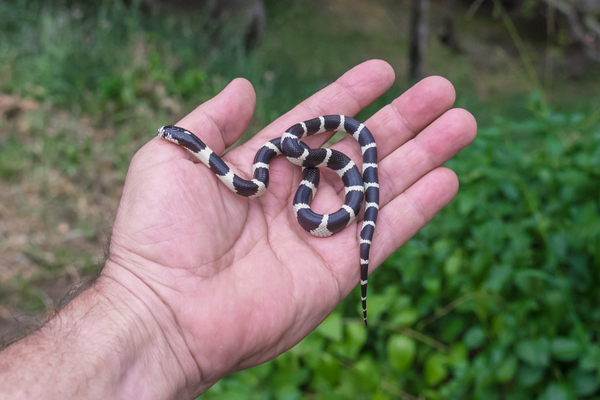
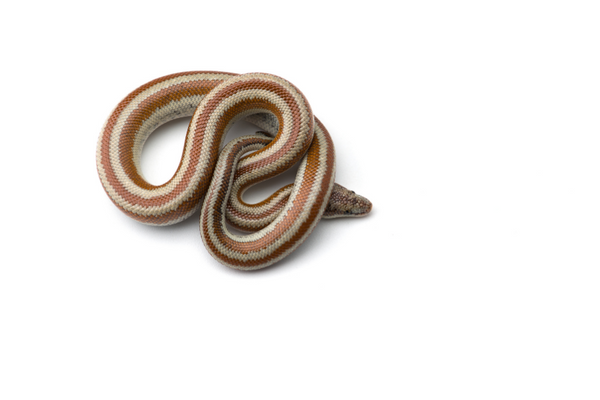





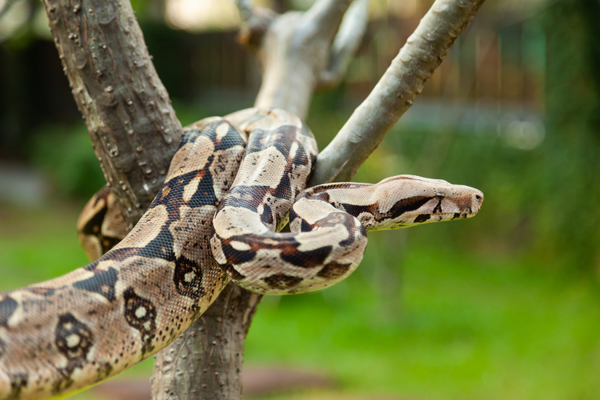
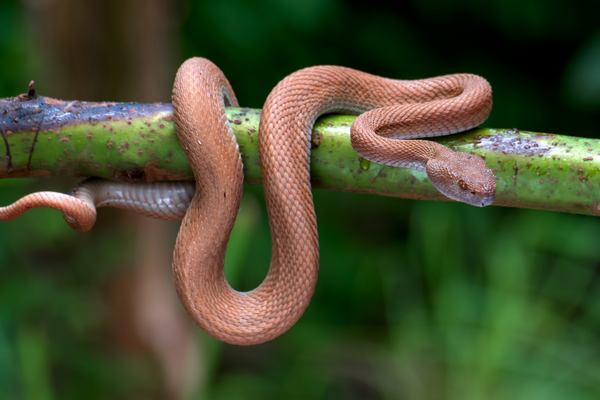


3.2. Diet and Feeding: Meeting Nutritional Needs
Snakes have specific dietary needs that vary by species. Some prefer frozen or thawed rodents, while others require live prey. Understand the feeding habits of your chosen snake, as both methods have pros and cons. Ensuring a balanced diet is vital for the snake’s health. Always consult with a reptile veterinarian to determine the best feeding plan for your snake.
3.3. Habitat and Environmental Needs: Mimicking Nature
Creating a proper habitat is essential for your snake’s well-being. Mimic the snake’s natural environment as closely as possible, including temperature gradients, humidity levels, and appropriate substrate. Install UVB bulbs to replicate sunlight, necessary for vitamin D production.
Snakes are cold-blooded, requiring temperature regulators to warm or cool their bodies. Provide basking areas with higher temperatures. Include bedding or substrate for comfortable crawling and hide boxes for privacy. PETS.EDU.VN offers a range of habitat accessories to enhance your snake’s living space.
4. Common Mistakes to Avoid as a New Snake Owner
New snake owners often make mistakes due to lack of experience. Here are common pitfalls to avoid:
4.1. Overhandling: Respecting Boundaries
Snakes have different personalities and habits. Some seclude themselves when feeding or shedding. Avoid overhandling during these times to minimize the risk of indigestion and incomplete shedding. Respect their boundaries to build trust and reduce stress.
4.2. Incorrect Feeding Practices: Proportional Prey
Research your snake’s diet preferences based on age and size. Ensure the prey is proportional to the snake’s girth. Wash your hands before and after feeding to prevent the snake from associating your scent with food. Incorrect feeding can lead to health issues and behavioral problems. PETS.EDU.VN provides detailed feeding guides for various snake species.
4.3. Poor Habitat Setup: Safety and Comfort
Construct snake enclosures carefully, ensuring they are escape-proof and provide a safe environment. Use secure lids and avoid sharp objects that could injure the snake. Incorrect habitat setups can cause stress and physical harm.
4.4. Neglecting Temperature Gradients: Maintaining Ideal Conditions
Maintaining correct temperature gradients is crucial. Body temperature affects a snake’s activities, such as feeding and shedding. High or low temperatures can cause stress and behavioral changes. Monitor the temperature regularly and adjust as needed to maintain optimal conditions.
4.5. Rescuing Without Proper Research: Health and Temperament History
Adopting snakes from rescue centers is commendable but requires caution. Ensure the snake has a good medical and temperament history. Rescued snakes may have infections or require special care that new owners cannot provide. Research reputable rescue centers to ensure the snake is healthy.
4.6. Skipping Veterinary Checkups: Preventative Care
Annual checkups are essential to assess your snake’s health, even if it appears healthy. Veterinarians can identify potential issues, such as malnutrition, diseases, or parasites. Preventative care is vital for maintaining your snake’s long-term well-being.
| Mistake | Consequence | Prevention |
| ————————– | ——————————————– | ———————————————————————– |
| Overhandling | Stress, indigestion, incomplete shedding | Respect boundaries, avoid handling during sensitive times |
| Incorrect Feeding | Health issues, behavioral problems | Research diet, ensure proportional prey, wash hands |
| Poor Habitat Setup | Injury, discomfort, escape | Use secure enclosures, avoid sharp objects, mimic natural environment |
| Neglecting Temp Gradients | Stress, behavioral changes, health problems | Monitor temperature, adjust as needed, provide basking areas |
| Rescuing Without Research | Potential health hazards, special care needs | Research reputable centers, ensure good medical history |
| Skipping Vet Checkups | Undetected health issues, long-term problems | Schedule annual checkups, preventative care |
5. Embracing the Rewarding World of Pet Snakes
Snakes make wonderful companion pets, offering unique experiences and rewards. With the right knowledge and care, you can provide a safe and healthy environment for your scaly friend. Remember, each snake has its unique temperament and maintenance needs, so thorough research is essential.
At PETS.EDU.VN, we are committed to providing you with the resources and support you need to succeed as a snake owner. Explore our website for detailed guides, expert advice, and a wide range of products to enhance your snake’s life. Embrace the fascinating world of snakes and discover the joy of reptile ownership!
If you’re ready to take the next step, visit pets.edu.vn today to find the perfect supplies and information to welcome your new pet snake into your home! Contact us at 789 Paw Lane, Petville, CA 91234, United States, or via Whatsapp at +1 555-987-6543.
6. FAQs: Addressing Common Concerns About Pet Snakes
Here are some frequently asked questions to help you better understand pet snake care:
Q1: What is the friendliest snake to have as a pet?
Corn snakes are often considered the friendliest due to their docile nature and low likelihood of biting. Their smaller size also makes them easier to handle.
Q2: What is the hardest snake to keep as a pet?
The difficulty varies depending on the snake species and the owner’s experience. Snakes with more complex requirements, such as Green Anacondas (due to their size and temperament), can be challenging for beginners.
Q3: Do snakes like to be pets?
Snakes do not have social or emotional needs like other pets. However, some can become accustomed to human contact and exhibit friendly behavior over time.
Q4: Which pet snake is least likely to bite?
Rosy Boas, Corn Snakes, Ball Pythons, and California King Snakes are known for their gentle nature and are less prone to biting.
Q5: How do I set up a proper temperature gradient for my snake?
Create a temperature gradient by positioning the heat source strategically to create both warm and cool areas within the terrarium. Monitor temperatures regularly to ensure they are within the appropriate range.
Q6: How can I ensure my snake’s enclosure is escape-proof?
Use secure lids with door wraps, wire loops, or solid grommets to prevent escapes. Regularly inspect the enclosure for any potential weak points.
Q7: What do I do if my snake stops eating?
Reduced appetite can be due to stress, incorrect temperature, or shedding. Consult with a reptile veterinarian to rule out underlying health issues.
Q8: How often should I handle my snake?
Start with short handling sessions (10-15 minutes) a few times a week and gradually increase the duration as the snake becomes more comfortable. Avoid handling during shedding or after feeding.
Q9: What are the signs of a healthy snake?
Signs of a healthy snake include clear eyes, smooth and intact skin, regular shedding, a healthy appetite, and active behavior.
Q10: How do I clean my snake’s enclosure?
Clean the enclosure regularly (weekly or bi-weekly) by removing waste, replacing substrate, and disinfecting surfaces. Use reptile-safe cleaning products to avoid harming your snake.
